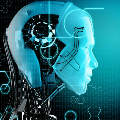Being able to create meaningful symbols and proficiently use them for higher cognitive functions such as communication, reasoning, planning, etc., is essential and unique for human intelligence. Current deep neural networks are still far behind human's ability to create symbols for such higher cognitive functions. Here we propose a solution, named SEA-net, to endow neural networks with ability of symbol creation, semantic understanding and communication. SEA-net generates symbols that dynamically configure the network to perform specific tasks. These symbols capture compositional semantic information that enables the system to acquire new functions purely by symbolic manipulation or communication. In addition, we found that these self-generated symbols exhibit an intrinsic structure resembling that of natural language, suggesting a common framework underlying the generation and understanding of symbols in both human brains and artificial neural networks. We hope that it will be instrumental in producing more capable systems in the future that can synergize the strengths of connectionist and symbolic approaches for AI.
翻译:----
神经网络中符号的出现以实现语义理解和通讯
能够创造有意义的符号并熟练将其用于高级认知功能,如通信、推理、计划等,对于人类智能而言至关重要且独特。当前的深度神经网络仍远远落后于人类创造这些符号的能力。在这里,我们提出了一种名为SEA-net的解决方案,以赋予神经网络创造符号、语义理解和通信的能力。SEA-net可以生成动态配置网络以执行特定任务的符号。这些符号捕捉了组成性语义信息,使系统能够通过纯符号操作或通信获得新的功能。此外,我们发现这些自动生成的符号展现出类似自然语言的内在结构,表明生成和理解符号的共同框架存在于人类大脑和人工神经网络之间。我们希望将来的更有能力的系统可以结合联结主义和符号方法的优势来实现人工智能的目标。





